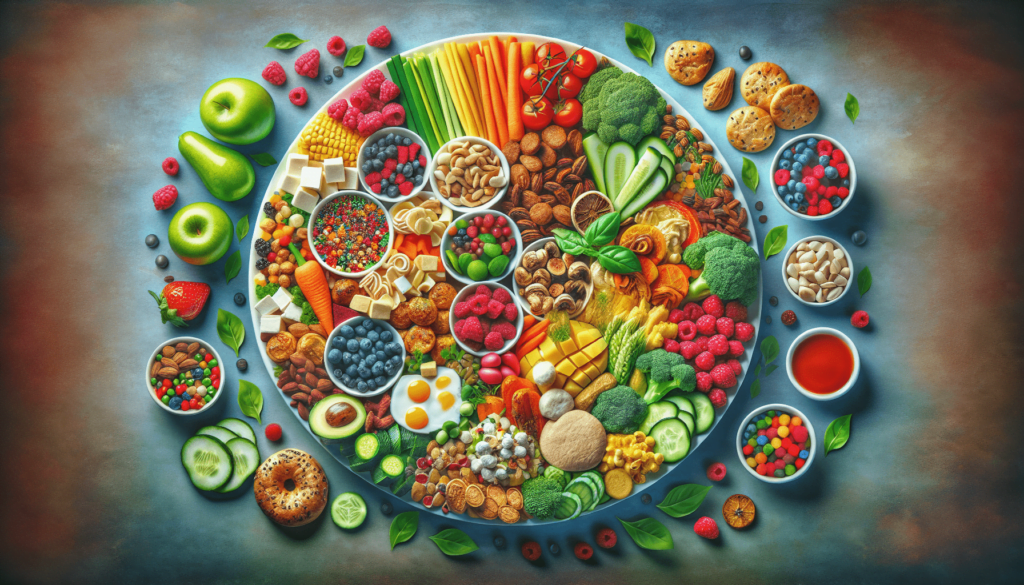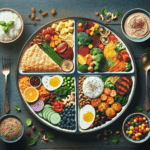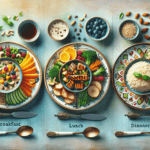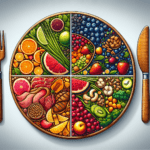Have you ever wondered if eating three meals a day is truly necessary for your health? With busy schedules and the rise of intermittent fasting and snacking culture, the idea of sticking to the traditional three meals a day can feel daunting. In this article, we discuss the age-old question of whether three meals a day is truly essential, and explore the potential benefits and drawbacks of adopting alternative eating patterns. So, if you’re curious to find out if you need to stick to this conventional eating schedule, keep reading!
Different Eating Patterns
When it comes to eating, there isn’t a one-size-fits-all approach. People have different habits and preferences when it comes to their eating patterns. In this article, we will explore three different eating patterns: intermittent fasting, two meals a day, and one meal a day. Each of these patterns has its own benefits and drawbacks, and understanding them can help you make an informed decision about which one may be right for you.
Benefits of Eating Multiple Meals
Traditionally, the idea of eating three meals a day has been ingrained in our minds. However, there are some undeniable benefits to eating multiple meals throughout the day.
Better Nutrient Absorption
By breaking your meals into smaller portions, your body has an easier time absorbing the nutrients from your food. When you eat larger meals, your digestive system can become overwhelmed, leading to incomplete nutrient absorption. By spreading your meals out, you give your body the chance to properly digest and absorb the essential vitamins and minerals it needs.
Constant Fuel for the Body
Eating multiple meals throughout the day ensures a constant supply of fuel for your body. This can help maintain stable energy levels and prevent the dreaded mid-afternoon slump. By providing your body with a steady stream of nutrients, you can keep your energy levels up and maintain focus throughout the day.
Prevents Overeating
Eating three meals a day can help prevent overeating. When you go for long periods without eating, you may be more likely to consume larger portions when you finally do sit down for a meal. By eating smaller, more frequent meals, you can avoid excessive hunger and make it easier to control your portion sizes.
Drawbacks of Eating Multiple Meals
While there may be advantages to eating multiple meals, it’s important to recognize the potential drawbacks as well.
Higher Calorie Intake
Eating multiple meals throughout the day can sometimes lead to a higher calorie intake. If you’re not mindful of portion sizes and the overall caloric content of your meals, it’s easy to consume more calories than your body actually needs. This can lead to weight gain and other associated health issues.
Digestive Strain
For some individuals, constantly digesting food can put a strain on the digestive system. Eating multiple meals throughout the day means that your digestive system is constantly working, which may be challenging for those with digestive issues or a sensitive stomach. It’s important to listen to your body and recognize any discomfort that may arise from this eating pattern.
Induces Food Cravings
When you’re eating multiple meals throughout the day, you may find yourself constantly thinking about food. This can lead to increased food cravings and potentially derail your healthy eating habits. It’s important to have a plan in place to prevent unnecessary snacking and make sure you’re choosing nutrient-dense foods to satisfy your hunger and stave off cravings.
Exploring Intermittent Fasting
Intermittent fasting has gained popularity in recent years as an alternative eating pattern to the traditional three meals a day approach. Let’s take a closer look at what intermittent fasting is, the different types of intermittent fasting, and its effects on metabolism and body composition.
What is Intermittent Fasting?
Intermittent fasting is not a diet, but rather an eating pattern that involves cycling between periods of fasting and eating. It places more emphasis on when you eat, rather than what you eat. There are several different types of intermittent fasting, but they all follow the same basic principle of fasting for a specific duration of time and consuming all of your calories within a defined eating window.
Different Types of Intermittent Fasting
The most common types of intermittent fasting include the 16/8 method, where you fast for 16 hours and eat all of your calories within an 8-hour eating window; the 5:2 method, where you eat normally for 5 days and restrict your calorie intake for 2 non-consecutive days of the week; and the alternate-day fasting method, where you alternate between fasting days and normal eating days.
Effects on Metabolism and Body Composition
Intermittent fasting has been shown to have a positive effect on metabolism and body composition. It can increase insulin sensitivity, which is beneficial for those at risk of developing type 2 diabetes. Additionally, intermittent fasting has been shown to promote autophagy, a cellular process that helps remove damaged cells and can have anti-aging effects. Some studies have also suggested that intermittent fasting may aid in weight loss.
Benefits of Intermittent Fasting
Improves Insulin Sensitivity
Insulin sensitivity refers to how responsive your cells are to the hormone insulin. When your cells are more insulin sensitive, they are better able to take up glucose from the bloodstream, which can help regulate blood sugar levels. Intermittent fasting has been shown to improve insulin sensitivity, which can be particularly beneficial for individuals with insulin resistance or prediabetes.
Promotes Autophagy
Autophagy is a process by which your body disposes of old and damaged cells, making way for new, healthy cells. This cellular clean-up process has been linked to various health benefits, including reduced risk of chronic diseases and improved longevity. Intermittent fasting has been shown to promote autophagy, potentially leading to these positive health effects.
Potential for Weight Loss
One of the main reasons why people turn to intermittent fasting is for weight loss. By restricting your eating window and creating a caloric deficit, you may naturally consume fewer calories, leading to weight loss. Additionally, intermittent fasting has been shown to increase fat burning and boost metabolism, which can further contribute to weight loss efforts.
Drawbacks of Intermittent Fasting
While intermittent fasting has its benefits, it’s important to consider the potential drawbacks as well.
Potential Nutrient Deficiencies
Restricting your eating window can make it more challenging to meet all of your nutrient needs, especially if you’re not consuming a well-balanced diet. With a limited time to eat, it’s important to focus on nutrient-dense foods to ensure you’re getting all of the vitamins, minerals, and macronutrients your body needs to function optimally. Additionally, certain nutrients, such as iron and calcium, may be harder to obtain in adequate amounts through an intermittent fasting approach.
Initial Adjustment Period
When starting intermittent fasting, many individuals may experience an initial adjustment period. Your body needs time to adapt to the new eating pattern, and you may feel hungry or fatigued during the fasting period until your body becomes accustomed to it. It’s important to be patient and listen to your body’s cues as you transition to intermittent fasting.
May Not Be Suitable for Certain Populations
Intermittent fasting may not be suitable for everyone. People with a history of disordered eating, pregnant or breastfeeding women, individuals with certain medical conditions, and those who have specific nutrient requirements should consult with a healthcare professional before trying intermittent fasting. It’s important to prioritize your overall health and well-being when considering any new eating pattern.
The Two Meals a Day Approach
Another eating pattern that has gained attention is the two meals a day approach. Let’s dive into how this approach works, the benefits it offers, as well as the potential drawbacks to consider.
How Does it Work?
The two meals a day approach, as the name suggests, involves eating two main meals throughout the day. Typically, individuals following this approach will have one meal in the morning or early afternoon and another meal in the evening. Outside of these meal times, only calorie-free beverages and possibly a small snack are consumed.
Balanced Meal Planning
When adopting the two meals a day approach, it’s essential to focus on balanced meal planning. Each meal should include a variety of food groups, such as lean proteins, whole grains, fruits, vegetables, and healthy fats to ensure you’re getting a wide range of nutrients. Additionally, it’s important to pay attention to portion sizes to avoid overeating during these two meals.
Effect on Hunger and Satisfaction
By condensing your meals into two larger meals, you may find that you feel more satiated and satisfied after eating. This can be especially beneficial for individuals who struggle with constant snacking or grazing throughout the day. Additionally, when spread out across two meals, you may find that you have more control over your hunger levels and are less likely to experience drastic spikes and dips in blood sugar.
Benefits of Two Meals a Day
Potential for Weight Loss
The two meals a day approach may promote weight loss by naturally reducing overall caloric intake. By limiting your eating window to only two meals, you naturally consume fewer calories compared to a traditional three-meal approach. Additionally, condensing your meals into two larger meals may help you feel more satisfied, reducing the overall desire for excessive snacking or consuming unhealthy foods.
Increased Energy Levels
By eating two balanced meals a day, you provide your body with a steady source of energy throughout the day. Instead of relying on frequent snacks or small meals to keep your energy levels up, you allow your body to fuel itself efficiently through the two main meals. This can prevent energy crashes and keep you feeling energized throughout the day.
Simplified Meal Preparation
With only two meals to plan for, meal preparation can become more streamlined and efficient. Instead of spending time and effort on three separate meals, you can focus on creating two well-rounded and satisfying meals. This can save you time in the kitchen and make it easier to stick to a healthier eating routine.
Drawbacks of Two Meals a Day
Difficulty in Meeting Nutrient Needs
When eating only two meals a day, it can be more challenging to ensure you’re meeting all of your nutrient needs. With fewer opportunities to consume a variety of foods, you need to be intentional about including all essential nutrients in your meals. This requires careful meal planning and potentially the use of dietary supplements to cover any gaps in your nutrient intake.
Social and Cultural Challenges
Adopting a two meals a day approach may come with social and cultural challenges. Many social gatherings and events revolve around food, and having a limited eating window may make it more challenging to fully participate in these situations. It’s important to find a balance between your chosen eating pattern and your social life, ensuring that you can still enjoy meals with family and friends while following your desired eating schedule.
Individual Variation in Tolerance
Like any eating pattern, the two meals a day approach may not be suitable for everyone. Some individuals may find it difficult to adjust to consuming larger meals, while others may struggle with managing hunger levels within a restricted eating window. It’s important to listen to your body and make adjustments as needed to find what works best for you.
Drawbacks of One Meal a Day
Potential for Nutrient Deficiencies
Opting for just one meal a day can make it challenging to meet all of your nutrient needs. Consuming all of your calories, vitamins, and minerals in one meal can be difficult, especially if you’re not careful about choosing a balanced variety of foods. Nutrient deficiencies can negatively impact your health, so it’s important to ensure you’re getting all of the necessary nutrients on a daily basis.
Effects on Metabolism
Eating just one meal a day can disrupt your body’s natural metabolic processes. With such a large time gap between meals, your metabolism may slow down, potentially leading to a decrease in overall energy expenditure. This can make it more difficult to lose weight or maintain a healthy weight.
Unsuitable for Certain Individuals
One meal a day may not be suitable for everyone. Certain populations, such as pregnant or breastfeeding women, individuals with diabetes, or those with specific dietary or medical conditions, should consult with a healthcare professional before considering this eating pattern. It’s important to prioritize your health and well-being and choose an eating pattern that aligns with your individual needs and circumstances.
In conclusion, there is no one-size-fits-all approach to eating. Different eating patterns offer various benefits and drawbacks, and it’s important to consider your own unique circumstances and goals when choosing an eating pattern. Whether you opt for intermittent fasting, two meals a day, or one meal a day, remember to prioritize nutrient-dense foods and listen to your body’s cues. By making informed choices about your eating habits, you can support your overall health and well-being.








